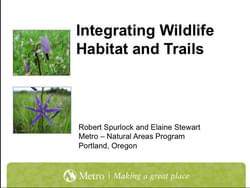




Enhancing Habitat and Building Compatible Trails
Improving trails for both wildlife habitat and trail users’ experiences.
by Robert Spurlock, Associate Regional Planner, Oregon Metro Regional Government, Elaine Stewart, Senior Natural Resources Scientist, Oregon Metro Regional Government, Emily Roth, Senior Planner-Environmental, Portland Parks and Recreation

Presenters: Robert Spurlock, Regional Trails Planner, Natural Resources Scientist, Oregon Metro; Elaine Stewart, Natural Resources Scientist, Oregon Metro; Emily Roth, Senior Environmental Planner, Portland Parks and Recreation, Oregon; Lisa Tyler, Construction Project Manager, Portland Parks and Recreation, Oregon
The Powell Butte Nature Park, one of Portland’s premier natural areas, is well used by Portland citizens whose continual activity eroded the soft surface trail system. Portland Parks completed a successful rebuild of the Nature Park’s trails, which accommodate a variety of users: pedestrians, mountain bikers, and equestrians. By working together at every step, from concept planning and design to construction and maintenance, planners and biologists can improve trails for both wildlife habitat and trail users’ experiences.
Sustaining Wildlife With Recreation on Public Lands
posted Nov 25, 2023
Humans and wildlife interact in multifaceted ways on public lands with both positive and negative outcomes for each group. When managed well, wildlife-based tourism and other forms of recreation can benefit conservation goals.
Environmental Impacts of Winter Recreation
posted Nov 25, 2023
Regardless of our intentions, many species perceive humans as a threat and respond accordingly. In general, animals respond to threats by first increasing vigilance (time spent looking around versus foraging), and running away if the threat is perceived to be imminent.
posted Nov 24, 2023
Winter recreation is a rapidly growing activity, and advances in technology make it possible for increasing numbers of people to access remote backcountry terrain. Increased winter recreation may lead to more frequent conflict between recreationists, as well as greater potential disturbance to wildlife.
Guidelines for Managing and Restoring Natural Plant Communities along Trails and Waterways
posted Sep 18, 2023
These guidelines are designed to assist resource managers in conducting management activities that enhance the quality of natural plant communities, wildlife habitat, regional landscape integrity and visual quality, particularly as related to planning, development, and maintenance of trails, water trails, and water access sites.
811 views • posted 02/19/2018